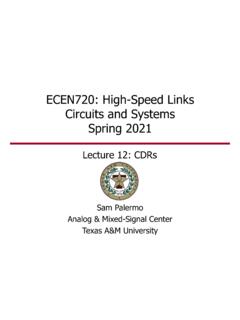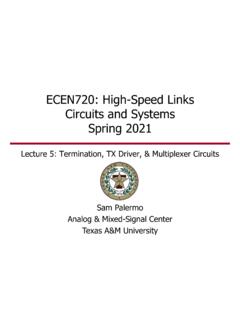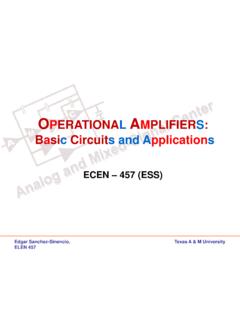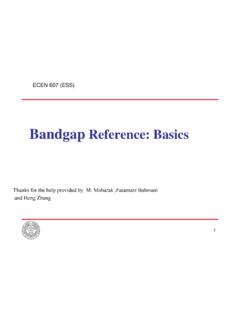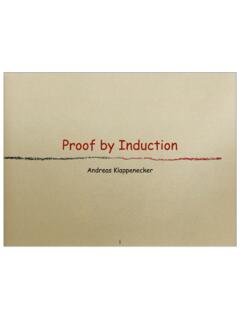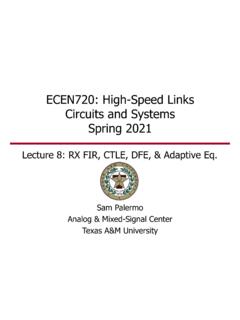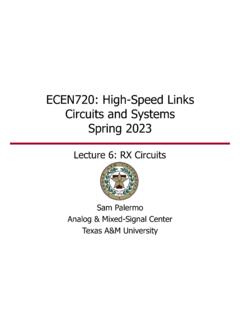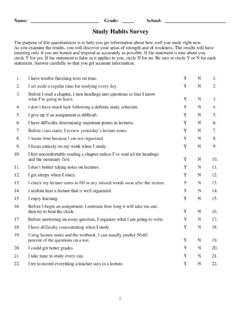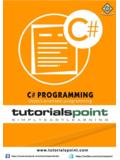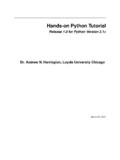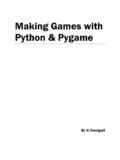Transcription of 37 SENSOR KIT TUTORIAL FOR UNO AND MEGA
1 1 / 165 37 SENSOR KIT TUTORIAL FOR UNO AND MEGA 2 / 165 Preface Our Company Established in 2011, Elegoo Inc. is a professional manufacturer and exporter that is involved in the design, development, production and marketing of Arduino accessories, 3D printers, Raspberry Pi accessories and STM32. We are located in Shenzhen which is known as the Chinese Silicon Valley. All of our products comply with international quality standards and are greatly appreciated in a variety of different markets throughout the world. Official website: US Amazon store front: CA Amazon store front: DE Amazon Store front: Vitrine l Amazon FR: A1780 XYQ9 DFQM6 Tienda de Amazon de ES.: IT Amazon negozio: A1780 XYQ9 DFQM6 UK Amazon storefront: Our TUTORIAL This TUTORIAL is geared for beginners. You will learn all the basic information about how to use Arduino controller board, sensors and components. If you want to study Arduino in more depth, we recommend that you read the Arduino Cookbook written by Michael Margolis.
2 Our after-sales If you have any question, comment or suggestion about our company, product or TUTORIAL , please don t hesitate to send an email to (US and CA) or (Europe). We are committed to continuous improvement so your feedback is invaluable. 3 / 165 Packing List 4 / 165 5 / 165 Lesson Listing Lesson 0 Installing IDE .. 6 Lesson 1 Add Libraries ..14 Lesson 2 TEMP AND HUMIDITYMODULE ..18 Lesson 3 DS18B20 DIGITAL TEMPERATURE SENSOR MODULE ..24 Lesson 4 BUTTON SWITCH MODULE ..30 Lesson 5 FOUR TYPE OF SWITCH MODULE ..34 Lesson 6 IR RECEIVER AND EMISSION ..43 Lesson 7 Active and passive buzzer ..51 Lesson 8 LASER MODULE ..58 Lesson 9 SMD RGB MODULE AND RGB MODULE ..62 Lesson 10 PHOTO-INTERRUPTER MODULE ..69 Lesson 11 DUAL-COLOR COMMON-CATHODE LED ..74 Lesson 12 PHOTORESISTOR MODULE ..80 Lesson 13 BIG SOUND SENSOR MODULE AND SMALL SOUND SENSOR MODULE ..86 Lesson 14 REED SWITCH AND MINI REED SWITCH MODULE.
3 92 Lesson 15 DIGITAL TEMPERATURE MODULE ..101 Lesson 16 LINEAR HALL AND ANALOG HALL MODULE ..108 Lesson 17 FLAME SENSOR MODULE ..117 Lesson 18 MENTAL TOUCH MODULE ..122 Lesson 19 7 COLOR FLASH LED MODULE ..127 Lesson 20 Magic light cup MODULE ..131 Lesson 21 JOYSTICK MODULE ..135 Lesson 22 TRACKING MODULE ..140 Lesson 23 Infrared 38 KHz obstacle avoidance module ..144 Lesson 24 ROTARY ENCODERS MODULE ..150 Lesson 25 1 CHANNEL RELAY MODULE ..156 Lesson 26 HEARTBEAT MODULE ..161 6 / 165 Lesson 0 Installing IDE Introduction In this lesson, you will learn how to setup your computer to use Arduino and how to set about the lessons that follow. The Arduino software that you will use to program your Arduino is available for Windows, Mac and linux . The installation process is different for all three platforms and unfortunately there is a certain amount of manual work to install the software. There is no installer program, but rather you have to unzip a folder which gives you an Arduino folder that contains the Arduino program and a few other items.
4 In a separate step, you must then install USB drivers, Installing Arduino (Windows) Get started by visiting the website. As of April 2014, we suggest using as is still in beta. If is no longer in beta by the time you read this, you can try it out! Start by downloading the zip file for Windows. There is only one version of the software, whether you are using Windows XP through to Windows 7. When the zip file has downloaded, extract the contents onto the Desktop, by right-clicking 7 / 165 on the file and selecting 'Extract ' from the pop-up menu. Next, select your Desktop and click 'Extract'. You can move it somewhere else onto your computer later, just by moving the folder, but for now, just keep it on the Desktop. The Arduino folder contains both the Arduino program itself and the drivers that allow the Arduino to be connected to your computer by a USB cable. Before we launch the Arduino software, you are going to install the USB drivers.
5 Plug one end of your USB cable into the Arduino and the other into a USB socket on your computer. The power light on the LED will light up and you may get a 'Found New Hardware' message from Windows. Ignore this message and cancel any attempts that Windows makes to try and install drivers automatically for you. The most reliable method of installing the USB drivers is to use the Device Manager. This is accessed in different ways depending on your version of Windows. In Windows 7, you first have to open the Control Panel, then select the option to view Icons, and you should find the Device Manager in the list. Under Other Devices , you should see an icon for unknown device with a little yellow warning triangle next to it. This is your Arduino. 8 / 165 Right-click on the device and select the top menu option (Update Driver ). You will then be prompted to either Search Automatically for updated driver software or Browse my computer for driver software.
6 Select the option to browse and navigate to the \ \drivers. 9 / 165 Click 'Next' and you may get a security warning, if so, allow the software to be installed. Once the software has been installed, you will get a confirmation message. That's it, you are now ready for action, so Skip the next section on installation on Mac and linux and move straight on to 'Boards and Ports'. Installing Arduino (Mac and linux ) Get started by visiting the website and downloading the matching IDE for your operating system. As of April 2014, we suggest using as is still in beta. If is no longer in beta by the time you read this, you can try it out! 10 / 165 Save the install software to your desktop or wherever The process for installing the Arduino software on the Mac is a lot easier than on the PC. As before, the first step is to download the file. In the case of the Mac, it is a zip file. Once downloaded, double-click on the zip file, which will extract a single file called.
7 This is the whole Arduino application, just drag it into your Applications Folder. 11 / 165 You can now find and launch the Arduino software in your Applications folder. As you are going to use it frequently, you may wish to right-click its icon in the dock and set it to Keep In Dock . There are many different linux distributions and the instructions for each distribution are a little different. The Arduino community has done a great job of putting together sets of instructions for each distribution. Boards and Ports You are now ready to start the Arduino Software, so whatever platform you are using, open the Arduino folder and open the Arduino application contained within it. 12 / 165 This will start the Arduino IDE, but before you can start programming, you have to tell the Arduino software which type of Arduino board you are using and also select the port to which it is connecting. To tell the Arduino IDE which type of board you are using.
8 From the 'Tools' menu, select Board and then 'Arduino Uno' or 'Leonardo' as appropriate. Also on the 'Tools' menu, you will find the 'Serial Port' option. Select this option. 13 / 165 If you are using Windows, there will probably only be one option here and it will either say COM3 or COM4. Even though there is only one option, you will still need to select it. If you are using a Mac or linux , there will be more options there, but it will usually be the top option in the list, as this will be the device most recently plugged in. This is useful, as the name of the port may not look like it has anything to do with Arduino. It will probably be called something like / or /dev/ttyUSBn. 14 / 165 Lesson 1 Add Libraries Once you are comfortable with the Arduino software and using the built-in functions, you may want to extend its functionality with additional libraries. What are Libraries? Libraries are a collection of code that makes it easy for you to connect to a SENSOR , display, module, etc.
9 For example, the built-in LiquidCrystal library makes it easy to talk to character LCD displays. There are hundreds of additional libraries available on the Internet for download. The built-in libraries and some of these additional libraries are listed in the reference. To use these additional libraries, you will need to install them. How to Install a Library Using the Library Manager To install a new library into your Arduino IDE, you can use the Library Manager (available from IDE version ). Open the IDE and click Sketch > Include > Library > Manage Libraries. The library manager will open and you will find a list of libraries that are already installed or 15 / 165 ready for installation. In this example, we will install the Bridge library. Scroll down the list to find it, then select the version of the library you want to install. Sometimes, only one version of the library is available. If the version selection menu does not appear, don't worry; it is normal.
10 Finally click on install and wait for the IDE to install the new library. Downloading may take time depending on your connection speed. Once it has finished, an Installed tag should appear next to the Bridge library. You can close the library manager. You can now find the new library available in the Include Library menu. If you want to add your own library open a new issue on github. 16 / 165 Importing a .zip Library Libraries are often distributed as a ZIP file or folder. The name of the folder is the name of the library. Inside the folder will be the following: .cpp file, .h file, often a file, examples folder, and other files required by the library. Starting with version , you can install third-party libraries in the IDE. Do not unzip the downloaded library; leave it as-is. In the Arduino IDE, navigate to Sketch > Include Library > Add .ZIP Library. You will be prompted to select the library you would like to add.

